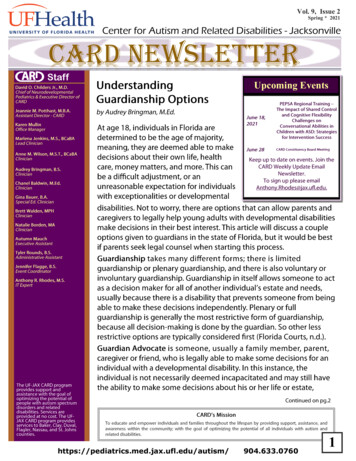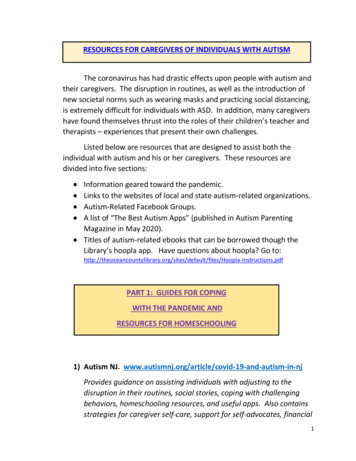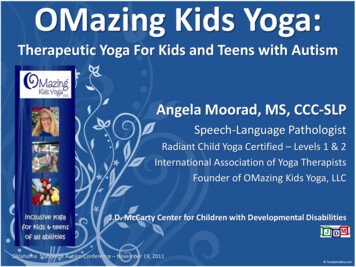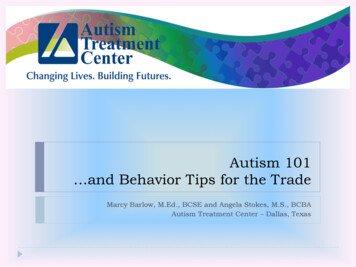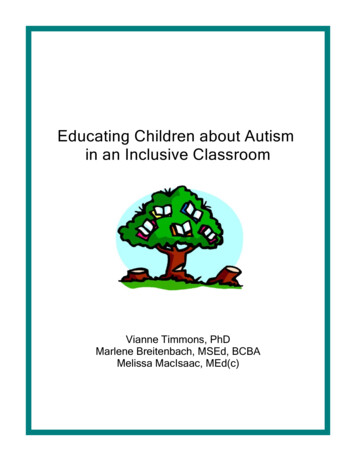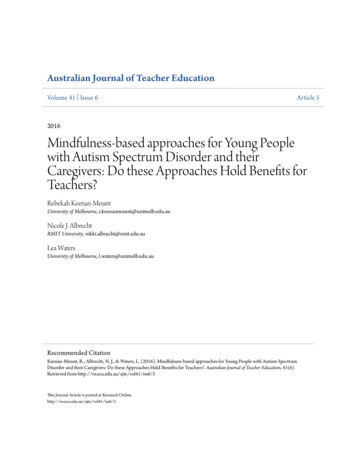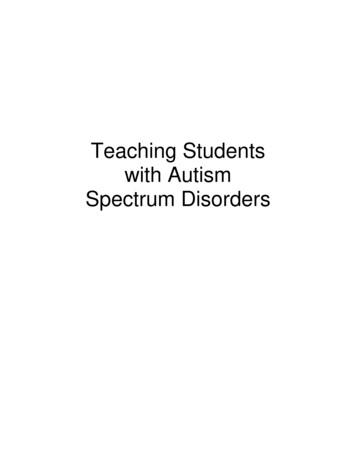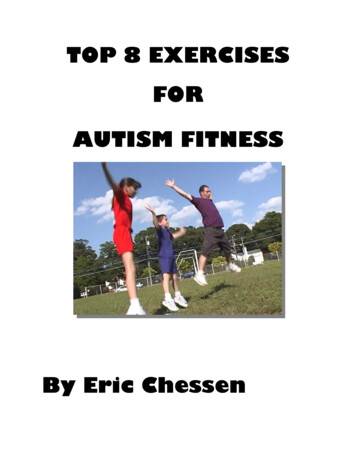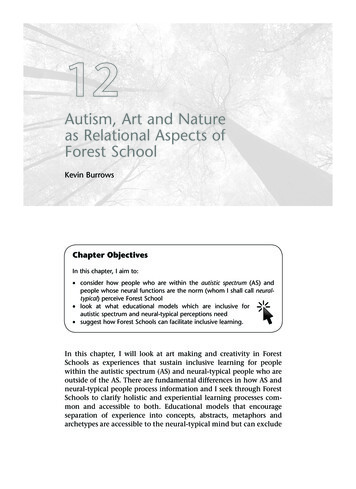
Transcription
Autism, Art and Natureas Relational Aspects ofForest SchoolKevin BurrowsChapter ObjectivesIn this chapter, I aim to: consider how people who are within the autistic spectrum (AS) andpeople whose neural functions are the norm (whom I shall call neuraltypical) perceive Forest School look at what educational models which are inclusive forautistic spectrum and neural-typical perceptions need suggest how Forest Schools can facilitate inclusive learning.In this chapter, I will look at art making and creativity in ForestSchools as experiences that sustain inclusive learning for peoplewithin the autistic spectrum (AS) and neural-typical people who areoutside of the AS. There are fundamental differences in how AS andneural-typical people process information and I seek through ForestSchools to clarify holistic and experiential learning processes common and accessible to both. Educational models that encourageseparation of experience into concepts, abstracts, metaphors andarchetypes are accessible to the neural-typical mind but can exclude13-Knight Forest-4195-CH-12.indd 16231/03/2011 6:12:49 PM
Autism, Art and Nature as Relational Aspects of Forest School 163Figure 12.1‘Acting out’ with mask and treeautistic perception and there is a need to develop inclusive modelsthat support both neural-typical and autistic learning. I suggest thatcreativity in Forest School woodland can reconnect the symbiosisbetween human and natural worlds and influence experiential learningmodels that are intrinsic and accessible to both AS and neural-typicalperception.Case Study 1: IvanIn a Forest School woodland in the south-east of England, 17-year-oldIvan has autism and finds verbal communication difficult. His speechis often abrupt and guarded and it is unusual for him to initiatedialogue, and when Ivan communicates it is usually connected tohis physiological needs. Ivan has taken himself off to a secluded partof the woods and is working alone. Modelling with clay, he is making a clay face on a tree. Ivan has been working undisturbed forsome minutes and has become engaged in creative dialogue withthe clay and tree. After about half an hour, Ivan begins to sing, andhis singing grows in strength and in confidence. I check that he is(Continued)13-Knight Forest-4195-CH-12.indd 16331/03/2011 6:12:50 PM
164 Forest School for All(Continued)OK; he indicates that he is and continues singing. His singing doesnot have words but his sounds appear to be a source of comfortto him. Ivan is relaxed, calm and outside of the guarded and agitated self that he can present in the classroom. It is difficult toknow what is going on for Ivan, but here working creatively inwoodland he is calm and relaxed and I sense a contentednessabout his demeanour.Forest Schools and Working in CooperativeCreative GroupsMy work with people who have autism in Forest School environments seeks to address the anxiety and confusion already present inthe autistic mind, which can be aggravated when set against ananthropocentric world view of deconstructed and mechanistic learning models. For the person who has autism, there are experiencesand environments with which their perception cannot cope, andsuch environments can cause them anxiety.Professor Rita Jordan (2007) points out that it is not the autism thatwe see but a reaction as secondary behavioural manifestation of thecondition. People who have autism are under severe stress, severeanxiety, because of their fractured perception of the world. In otherwords, the person with autism can demonstrate extreme anxiety inenvironments that are outside their autistic perception of the world.My own observations that Forest School environments seem to calmAS students may be explained as reduced hypersensitivity which inturn reduces anxiety.Carl Delacato (1974) in his ‘Delacato Method’, advocates that forthose in the AS, these are times of polarised perception and anxiety-ladenbehaviour. In ‘hypersensitivity’, the senses become hypersensitive, wherelights flicker and sound is amplified, and in ‘hyposensitivity’, there issensate shutdown or withdrawal from overloaded sensation, wheresenses become dull.My work takes place in woodland which I believe can evoke a communicative and beneficial human reaction, promoting a sense of13-Knight Forest-4195-CH-12.indd 16431/03/2011 6:12:50 PM
Autism, Art and Nature as Relational Aspects of Forest School 165the Forest School as a holding container. This nurturing ForestSchool container foregoes concepts of abstract and metaphor andforms pedagogies that hold and reciprocate experiences of wild andsensed perception in both neural-typical and autistic mindsets.Olga Bogdashina (2003: 46–52) cites autistic perception and worldview as ‘Gestalt perception’ where the unprocessed and the experiential is simultaneously perceived as ‘fragmented’ or ‘distorted’ perceptions of self and world. That is, a world where experiences of selfand environment are unprocessed and unfiltered, with sensationsthat in busy, discordant environments can become overwhelming.Is it then that ‘Gestalt perception’ offers a view of self that is entwinedand interconnected with the environment and, if so, can the environment evoke either hyper or hypo sensate AS experiences?Observing AS students’ behaviour in both Forest School and withinmore rigid mechanistic classroom situations, I hypothesise thatForest Schools can nurture a relational experience of ‘self’ with‘other-than-self’. Forest Schools can become environments that areinclusive of Gestalt perception which can regulate and contain‘hypersensitivity’ and reduce anxiety for those in the AS. Other‘unnatural’ environments that promote deconstructed, distorted andfragmented notions of ‘self’ as separate from ‘other-than-self’ can beconfusing for the AS learner and can increase their ‘hypersensitivity’and anxiety.In my own Forest School practice, relational learning is achieved byworking within the group structure of the ‘story-telling circle’ (seeFigure 12.2 below), a circle of logs in a wooded glade where studentsinitiate and share story telling, their own stories inspired by objectsfound in the woodland.This is rather like an acted-out social story where power dynamics canbe worked through, experientially and creatively. Multimodal expressive arts, concepts of mask making and the dancing of masks, and‘acting out’ (as in Figures 12.1 and 12.3) increase the potential forphenomenological and experiential interaction and inclusion, empowering social relationality, communication and feelings of self-worth.Experiential learning from acting out takes place in a larger woodedglade or other part of the woodland and the acting-out activity isthen reflected upon in the story-telling circle. Here students have achance to reflect, empathise and develop understanding of their own13-Knight Forest-4195-CH-12.indd 16531/03/2011 6:12:50 PM
166 Forest School for AllFigure 12.2The storytelling circleFigure 12.3‘Acting out’ with mask and gloveand each others’ feelings or, better put, ‘behaviours’, promoting a betterunderstanding of themselves and their relationship to the group. Theexperience and reflection help form a consolidation of emotionalawareness, social skills, sense of self-image and self-worth, meetinginclusion and belonging needs. These newly discovered feelings andpatterns can then be developed further in the wider outside world.13-Knight Forest-4195-CH-12.indd 16631/03/2011 6:12:51 PM
Autism, Art and Nature as Relational Aspects of Forest School 167Creative Arts therapist Ilka List (2008: 80) speaks of a ‘secret garden,healing through nature’ where she expands the expressive arts therapy,sand tray ‘worlds’ of psychotherapist Margaret Lowenfeld (2007: 4–6)as ‘simultaneous perception’ in natural environments.Forest Schools have these very same qualities as places that can facilitate expressive arts and play therapy, ‘worlds’ as places of ‘simultaneous perception’ between self and the natural environment. I arguethat the dialogue of expressive arts and play in Forest School environments is a way forward for education and therapy models that areaccessible to both AS and neural-typical perception and processing.Case Study 2: Matt – Research project to assesswhat is experienced during non-verbal dialogueusing clay, tree and selfNeural-typical Matt, who is a member of Counsellors andPsychotherapists Outdoors (CAPO), agrees to take part in a groupexercise in woodland on the shores of Lake Coniston in the LakeDistrict. The exercise concerns the potential dialogue through creative process in woodland. Matt has recently received news of theviolent death of a close neighbour, and the news is still raw. Theimage Matt creates is of a screaming face over the wound where atree has had a branch torn from its trunk (Figure 12.4). Matt worksquietly alone with the tree and clay for over half an hour, followedby a reflective semi-structured interview. During the interview, Mattexplains that:‘Where pain is formed over the loss and wound, it is a healing process.’He also said that the creative process in woodland was very deepfor him and that the reciprocal process between self, clay and treealone, without the need to externalise through language, was enough,that there was a healing through the senses.Why Outside? Why Forest Schools?I have noticed considerable growth in my (16–19 years) AS students’value of self, self-esteem and communication skills. Students appearto respond positively to being in the Forest School creative groupwork container of natural woodland. I call this Forest School becausethe woodland environment experience has further enhanced learning for the special needs of this learning group. My thought is that13-Knight Forest-4195-CH-12.indd 16731/03/2011 6:12:51 PM
168 Forest School for AllFigure 12.4Matt’s clay face over the wounded branchwoodland intrinsically nurtures whereas mountain and wildernesschallenge. What is it exactly that happens in a woodland or forestenvironment that is different from other natural environments? Todistinguish a Forest School’s function from other natural environments, let us look at some aspects of ecotherapy practice. Wildernessand adventure therapy sometimes seek to take people, for exampledysfunctional adolescents, out of their ‘comfort zone’ through relational experience in nature as a kind of ‘hero’s quest’. The aim is toface and conquer fears and challenge behaviours, encouraging profound experiences in nature at transitional moments in their lives.But then they must return to urban environments, not being able tomake sense of, accommodate or sustain what has been experienced,what psychotherapist and ecotherapist Martin Jordan (2009) calls a‘psychological one night stand with nature’.The wilderness and the mountain are places of pilgrimage which traditionally seek inner strength, knowledge and understanding of ‘self’ –they are places to disassemble the self, to face demons, to conquerfears, to accommodate life change. At the ‘Wilderness and InnerSpace’ conference hosted by the University of Kent, psychotherapistMartin Stanton (2009) spoke of wilderness and wildness as ‘primalresonance between the raw and wild in nature’, whilst at the sameconference artist and psychotherapist Tessa Adams (2009) spoke about13-Knight Forest-4195-CH-12.indd 16831/03/2011 6:12:51 PM
Autism, Art and Nature as Relational Aspects of Forest School 169mountains as ‘environments of wonder and fear’, suggesting that theraw experience in natural spaces resonates with the internal raw andsometimes fearful landscape of the self. I agree that nature offers wildand often dark places of transference, soul searching, awe and wonderand that it is through this inner–outer perception of self and otherthat transitional spaces in nature can heal. But how can this be for theperson who has autism, whose Gestalt perception has no capacity foraffective resonance or empathy for ‘place’ or ‘other-than-self’ formedthrough abstracts or metaphors? It is relationality and belongingnessin nature that my work seeks. Ecologist David Abram (1996: 116–17),in regard to natural places as places of learning and relationalitybetween the ‘human’ and ‘other than human self’, speaks aboutNorth American ‘Vision Quest’ and the Aboriginal ‘Walk About’. Thisechoes the ways in which indigenous oral cultures turn towards theirrelationship with the Earth for teachings that must vitalise and sustain the human community. In my own European culture, woodlandwas once the predominant feature of the English landscape, pocketsof which are still in existence today as are the myth and legend of myown indigenous woodland culture and eco-schema. Forest Schoolpractitioner Sara Knight (2009: 94) reflects that there is somethingmagical and enchanting about woodland: ‘trees have an additionalmagic of their own’. The ‘Green man’ and ‘Jack in the green’ arethought to date back to wild or feral men of the woodland (see www.icons.org.uk, 2009). Woodland may be seen as one of our indigenouseco-schemas and the ‘feral-woodland-mind’, one of experiential andrelational perception. Although today these mythical beings or ‘selves’may be viewed as metaphors, there is always a subjective, experientialand sensate origin to all metaphor. Can we rediscover our former stateof wildness in a woodland environment through sensate phenomenological experience? Our woodland eco-schema is the experientialplace of the feral self (Green man, Jack in the green) given whatpresents itself through a phenomenological experience. It is wherenature is viewed as experiential and relational, rather than as predetermined cognitive thought abstracted from metaphor and archetype.Educationalists Colin Beard and John P. Wilson (2009: 162–5) discussthe outdoors as places that awaken the senses and increase experiential learning, and in part suggest that it is the sensate natural rhythmicqualities in nature that meet our experiential learning needs. Theydescribe outdoor spaces of mangrove and forest as places where thesenses are more in tune with the natural rhythms of the outdoor environment and a vital part of our ability to create a good experientiallearning climate. Clinical psychologist George W. Burns, (1998), comments on our psychological and biological ‘hard wiring’ being triggered13-Knight Forest-4195-CH-12.indd 16931/03/2011 6:12:51 PM
170 Forest School for Allby natural stimuli and that the environment is much more than allocationfor experiential learning and an integral part of experience. In herwritings on ‘creating restorative eco-therapeutic practices’, psychologistMary Watkins, (2009) refers to her therapeutic space in the woodland‘environment as a holding and sustaining force’. Child psychologistAnita Barrows (cited in Roszak et al., 1995: 104) notes that ‘nature hasalways been a holding environment for me’.Ideas about phenomenological experience through the aesthetic of theexpressive arts are also present in psychologists’ Kaplan and Kaplan’s(1989: 10–11, 195–7) work on restorative environments. Kaplan andKaplan conceptualise and research restorative environments and comment that perceptual aesthetic reactions that support effective humanfunctioning indicate the existence of an ancient and far-reachinghuman behavioural function of unconscious assessment of environments. That is, human reaction to natural environments can be beneficialthrough what environmental psychologist Terry Hartig, (2004: 273–9)calls ‘Restorative Environment as a Health Resource’.Case Study 3: SteveSteve is 18 years old and was diagnosed in his early years as beingwithin the autistic spectrum (AS). Steve has attended mainstreamschools with a Special Education Needs (SEN) support worker, andhe came to my work setting from a mainstream secondary school ayear ago. Initially, he was withdrawn and cautious. Steve initiallyfound it difficult to form relationships outside of the adults who workin our unit. In unstructured times, he can move into what seems tobe ‘standby’ mode where he focuses on a fixed space as if blottingout all around him.When being asked questions in a classroom situation, he can appearnot to be paying attention and he focuses his gaze on a quiet part ofthe room, the floor, a wall or something bland; Steve does not makeeye contact. I read that in his behaviour he is trying to find somewhere visually quiet to reduce his hypersensitivity in busy or noisysurroundings. It is apparent that he has some recognition of the content of the lesson as he will repeat back what is said; his written workis good as is his reading, both at E1 (entry level 1). Steve delivers hiswords in a fast and abrupt stream of verbal language, which to theuninitiated can come over as being provocative. However, he is verypolite and always uses ‘please’ and ‘thank you’ which softens reactionfrom first-time acquaintances. His words are fast, mechanical, almost13-Knight Forest-4195-CH-12.indd 17031/03/2011 6:12:51 PM
Autism, Art and Nature as Relational Aspects of Forest School 171spat out and he often repeats the same phrases or passages associatedwith the same theme. He has a wonderful smile and often laughs.My early assessment of Steve was made from my observations in aregular classroom with tables, chairs, posters and all the usual ‘busy’paraphernalia that goes on in indoor classrooms. Since then, wehave worked outside in the ‘Forest School’ woodland area wherethe tasks set were to look for found objects in the woodland andreturn to the story-telling circle based on a circle of logs around a‘fire pit’. Steve’s objects, were an old saucepan, a brick and a pieceof ivy. On his first few sessions in the woodland, he sat quietly withthe objects, occasionally moving them around but mostly staring atthe ground they occupied. Over a period of time, he was able toconstruct a semblance of a story to do with the found objects. Thecontent of the story is unimportant but his ability to assess andinterrelate has improved over a long period of time.How People Within the Autistic SpectrumPerceive, and the Domestication and Lossof Wild ExperienceIs it the environment that the neural-typical population have builtthrough perceived separation from and domination of nature thatpeople with autism find anxiety laden? Adventure therapist NickTotton (2009) (www.bacp.co.uk/5iatc/keynotes.php) suggests thatwe have ‘forgone our wildness through our own domestication’. Itis not unreasonable to suggest that the ‘world’ outside of autisticperception is Totton’s civilised, domesticated ‘world’. For the personwho has autism, I suggest that there already exists a wildness ofautistic perception, which is trapped in a ‘civilised’, neural-typicalworld imbibed with domestic rules of separation judgement, valueand isolation.Temple Grandin has drawn parallels with her own autistic perceptionand animal sensory-based thinking, linking perception of environment and behaviour to her profession as ‘livestock handling system’designer. Similarities between her autistic perception and animal sensate experience have enabled Grandin to create stress-free environments for cattle and other livestock. Drawing on her own autisticexperience, Grandin (Grandin and Johnson, 2005: 30–50) suggeststhat fear is the main emotion in an animal and in autism and that13-Knight Forest-4195-CH-12.indd 17131/03/2011 6:12:51 PM
172 Forest School for Allfor the person with autism, thinking is based on a ‘non abstracted’world perception of what she terms ‘seeing in details’. Seeing what isactually there, what is sensed, rather than seeing the abstract projection of inner concepts as outer worlds. That is, she perceives in sensory-based thinking, in sounds, thinking in touches and thinking inpictures. There is, I suspect, a commonality of reduced anxiety andstress between perceived relationship of sensory thinking, sensateexperience and environment, in both Grandin’s cattle corral andstockyard designs and the fragmented world perception of those whohave autism.Why Art and Creativity?In light of Cozolino’s assessment of Grandin’s neural functioning,one can understand that the person within the AS does not deconstruct or form abstracts through language acquisition, but interpretsinformation through visually oriented processing as a direct experiential process.Happ’e and Frith (2006), Howlin (1997: 39–40), Ozonoff et al. (1994)and Cozolino (2006: 280–9) state that the brain architecture andneural processing of people who have autism show deficits in ‘centralcoherence’, ‘the ability to form abstracts’, ‘executive functioning’ and‘language acquisition’, i.e. the neural processes that connect cognitive flexibility, abstract thinking and the ability to initiate or inhibitappropriate actions.Cozolino (2006: 287–9) states that Temple Grandin’s AS brain architecture shifts perception from cerebellum-dependant language areasto her visual cortex enabling her to think in images.Baron-Cohen (cited in Harvey et al., 2007: 351–62) suggests that people within the AS have impaired theory of mind which means aninability to understand, empathise or perceive others’ beliefs, desiresand intentions as different or separate from the self.Minshew (cited in Dunn Buron and Wolfberg, 2008: 55 and in Grandinand Johnson, 2005: 33) states that people within the AS can better process information through visual–spatial and visually oriented processing.Cozolino, Baron-Cohen and Minshew’s findings affirm that peoplewho have autism can process direct experience, through their visual13-Knight Forest-4195-CH-12.indd 17231/03/2011 6:12:51 PM
Autism, Art and Nature as Relational Aspects of Forest School 173cortex, without the ability or need to empathise or build innerabstracts, metaphors or symbols. The person within the AS has nomeans to externalise experience as ‘other than self’ and cannotform notions of the separation of their Gestalt perception into ‘self’and ‘other-than-self’ as they perceive holistically. The person withautism’s inability to empathise or build inner abstracts that connect to concepts about outer worlds separate from the self, invitesinterconnectedness through visual and experiential channels ofbrain function that are ‘relational’ rather than ‘deconstructive’.James Hillman’s development of Jung’s concept of ‘Active imagination’ into imaginal psychology has a bearing upon image making asa phenomenon of experience.Jung’s practice of active imagination follows the artistic tradition ofencouraging characters and images to reveal themselves, to speak forthemselves and to influence the person who contemplates them(McNiff, 1992: 110; Chodorow, 1997: 2–3, 8–9).Psychotherapist James Hillman (1972: 201) argues that the imaginalforgoes the need to translate or reformulate in a bid to rationalise,interpret or analyse the dream or fantasy into abstract or archetype.Expressive art therapists Knill, Levine and Levine (2004: 21–3, 81)and McNiff (2009: 41–7) have embedded active imagination, thephenomenological and the imaginal as key tenets of expressive artstherapy. Stating that, we are free to look at the world and our mentallife as phenomena of experience as images, as particular phenomena,distinct from symbols.The creative process offers ways to process our relational worldthrough phenomenological and imaginal experiences of activeimagination. There is arguably an accessibility of a duality betweenAS and neural-typical perception through therapy and educationparadigms, that recognise imaginal perception within the visualand experiential language of the expressive arts. This has particular prevalence in a Forest School environment where the relational aspect of learning through the senses takes president overdeconstructive methodologies. The Forest School enables relational and experiential processing through the senses by providing an environment where Gestalt perception can become thefunction of learning. Gestalt perception and learning processes a holistic view of self and other-than-self as one simultaneous experience13-Knight Forest-4195-CH-12.indd 17331/03/2011 6:12:51 PM
174 Forest School for Allof interrelation. Here Gestalt perception is processed through (noninterpretive) imaginal experience of the senses as the active imagination’s imagery of the creative and visual arts accessed through to thevisual cortex.Case Study 4: Research project with peoplewho have neural-typical perception to assesswhat is experienced during non-verbal dialogueusing clay, lake and selfA second CAPO member Rose was sceptical about the visual andtactile process and later stated that it was not an exercise that sheparticularly looked forward to. Rose had an initial aversion to clayand to working creatively. Rose worked by the lakeside at the shoreline and found that she soon became enmeshed within the rhythmsand patterns of the lake’s ebb and flow between water and theland. She found that she could form a connection with the patternsand rhythms of the lake by working through direct movement intothe clay as rhythmic sensation (see Fig 12.5) rather than externalaesthetic decision. It was as if by bypassing the metaphoricallanguage of aesthetic forming, she created a direct response throughsensation.Figure 12.513-Knight Forest-4195-CH-12.indd 174Water rhythms in clay31/03/2011 6:12:52 PM
Autism, Art and Nature as Relational Aspects of Forest School 175ConclusionI believe that experiential, creative and expressive arts cooperativegroupwork in Forest Schools can encourage inclusive learning commonto AS and neural-typical perceptions. Forest Schools are environments that can reduce hypersensitivity and enhance deeper primalexperiences of self, in relation to other-than-self. Key to inclusiveteaching of AS and neural-typical mindsets are paradigms and methodological pedagogies delivered through the active imagination ofthe creative process and accessed through the visual cortex. Notionsof what is experienced rather than what is conceptualised are accessible to all living beings and it is the deconstruction and separationof human from nature that excludes us from our wildness.Discussion Points What are the strengths of experiential learning? What are the weaknesses of mechanistic deconstructive pedagogies? Are you aware of any AS, neural-typical inclusive models of learning?Further ReadingBeard, C. and Wilson, J.P. (2009) Experiential Learning. London and Philadelphia:Kogan Page.Bogdanashina, O. (2003) Sensory Perception Issues in Autism. London: JKP.Buzzell, L. and Chalquist, C. (2009) Ecotheraphy. San Francisco, CA: Sierra Club Books.Dunn Buron, K. and Wolfberg, P. (eds) (2008) Learners on the Autistic Spectrum: PreparingHighly Qualified Educators. Kansas City, MO: Autism Asperger Publishing Co.Knill, P., Levine, E. and Levine, S. (2004) Principles and Practice of Expressive ArtsTherapy: Towards a Therapeutic Aesthetics. Philadelphia: Jessica Kingsley Press.ReferencesAbram, D. (1996) The Spell of the Sensuous. New York: Vintage.Adams, T. (2009) The Mountain Sublime, in Wilderness and Inner Space Conference,report hosted by the University of Kent. Available at: nferenceReport WildemessandlnnerSpace.pdfBaron-Cohen, S. (2007) in Harvey, P., Fossati, P. and Lepage, M. (2007) ‘Modulationof Memory Formation by Stimulus Content: Specific Role of the MedialPrefrontal Cortex in the Successful Encoding of Social Pictures’. Journal of13-Knight Forest-4195-CH-12.indd 17531/03/2011 6:12:53 PM
176 Forest School for AllCognitive Neuroscience [online], 19: 351–62 Available at: ture%20encoding.pdfBarrows, A. (1995) The Ecopsychology of Child Development, in Roszak, T., Gomes, M.,Kanner, A., Brown, L. and Hillman, J. (eds) (1995) Ecopsychology Restoring theEarth Healing the Mind. San Francisco: Sierra Club Books.Beard, C. and Wilson, J.P. (2009) Experiential Learning. London and Philadelphia:Kogan Page.Bogdanashina, O. (2003) Sensory Perception Issues in Autism. London: JKP.Burns, G. (1998) Nature Guided Therapy: Brief Integrated Strategies for Health and Wellbeing. Philadelphia: Brunner/Mazel.Buzzell, L. and Chalquist, C. (2009) Ecotheraphy. San Francisco, CA: Sierra ClubBooks.Chodorow, J. (1997) Jung on Active Imagination. Princeton, NJ: Princeton UniversityPress.Cozolino, L. (2006)The Neuroscience of Human Relationships: Attachment and theDeveloping Social Brain. New York and London: W.W. Norton.Delacato, C. (1974) ‘The Ultimate Stranger’, in The Autistic Child. Noveto, CA:Academic Publications.Dunn Buron, K. and Wolfberg, P. (eds) (2008) Learners on the Autistic Spectrum: PreparingHighly Qualified Educators. Kansas City, MO: Autism Asperger Publishing Co.Grandin, T. and Johnson, C. (2005) Animals in Translation: The Woman who ThinksLike a Cow. London: Bloomsbury.Happ’e, F. and Frith, U. (2006) ‘The Weak Coherence Account: Detail-FocusedCognitive Style in Autism Spectrum Disorders’, Journal of Autism and DevelopmentalDisorders, Vol, 36, No, 1.Hartig, T. (2004) ‘Towards Understanding the Restorative Environment as a HealthResource’ in Spielberger, C. et al. (eds) (2004) Encyclopaedia of Applied Psychology.San Diego: Academic Press.Hillman, J. (1972) The Myth of Analysis. New York: Harper Torchbooks.Howlin, P. (1997) Autism: Preparing for Adulthood. London: Routledge.Jordan, M. (2009) Lecture at Landscapes of the Mind Conference, 25–27 September,The Eden Project. Available at: www.traydio.com/UserConsole/ViewArticle.aspx?Title Marlin Jordan speaking at Sept 2009 Confer conference onLandscapes of the Mind&ArticlelD 2733Jordan, R. (2007) ‘Rita Jordan on Causation’ audio clip. Available at: Kaplan, R. and Kaplan, S. (1989) The Experience in Nature: A Psychological Perspective.New York: Press Syndicate of the University of Cambridge.Knight, S. (2009) Forest Schools and Outdoor Learning in the Early Years. London:
itate expressive arts and play therapy, ‘worlds’ as places of ‘simultane-ous perception’ between self and the natural environment. I argue that the dialogue of expressive arts and play in Forest School environ-ments is a way forward for education and therapy models that are accessible
